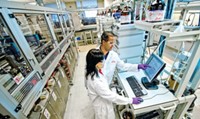Advertisement
Grab your lab coat. Let's get started
Welcome!
Welcome!
Create an account below to get 6 C&EN articles per month, receive newsletters and more - all free.
It seems this is your first time logging in online. Please enter the following information to continue.
As an ACS member you automatically get access to this site. All we need is few more details to create your reading experience.
Not you? Sign in with a different account.
Not you? Sign in with a different account.
ERROR 1
ERROR 1
ERROR 2
ERROR 2
ERROR 2
ERROR 2
ERROR 2
Password and Confirm password must match.
If you have an ACS member number, please enter it here so we can link this account to your membership. (optional)
ERROR 2
ACS values your privacy. By submitting your information, you are gaining access to C&EN and subscribing to our weekly newsletter. We use the information you provide to make your reading experience better, and we will never sell your data to third party members.
Energy
Taxes: Push Continues For Permanent R&D Credit
by Glenn Hess
January 24, 2012
| A version of this story appeared in
Volume 90, Issue 4
Congress is expected to take up legislation early this year to retroactively renew a variety of tax breaks that expired at the end of 2011, including the R&D tax credit. The tax package will likely extend the credit for another year. But a bipartisan group of legislators in the House and Senate is expected to push to include provisions from bills they introduced in the first session of the 112th Congress that would increase the value of the R&D credit and make it permanent.
“America is the world’s leading innovator, but we’re losing ground to competitors around the world,” says Rep. John B. Larson (D-Conn.), cosponsor of the American Research & Competitiveness Act (H.R. 942). “It’s time we get back on the playing field by modernizing the R&D tax credit and keeping American jobs and innovation here at home.”
H.R. 942 would increase the value of the credit from 14% to 20% and make the tax break permanent. A companion measure (S. 1577) is pending in the Senate.
A key aspect of the R&D tax credit is that only research conducted in the U.S. qualifies. Without this incentive, advocates say, firms are likely to locate new R&D operations—and the associated jobs—in other countries where tax regimes are more favorable.
The Society of Chemical Manufacturers & Affiliates “has long supported using the R&D tax credit to encourage U.S.-based chemical production of innovative new products, which is unique to SOCMA’s membership base of specialty chemical manufacturers,” says William E. Allmond IV, the trade group’s vice president of government relations.
The tax credit was originally enacted into law in 1981 as an incentive for spurring private-sector investment in R&D, fueling new product development, and ultimately creating new jobs. Congress, however, has been reluctant to permanently authorize the credit given its high cost, which is now estimated at $6 billion to $8 billion per year.



Join the conversation
Contact the reporter
Submit a Letter to the Editor for publication
Engage with us on Twitter